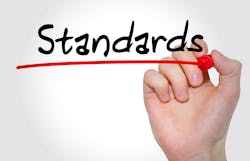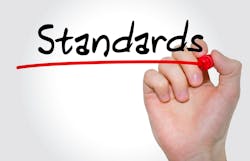Executive Q&A: The evolution of ONVIF’s Profile M standard
The push for standards and operating consistencies have been an almost Quixotic quest for manufacturers, systems integrators and end-users to facilitate open systems and interoperability. When ONVIF (Open Network Video Interface Forum), a global and open industry forum, was established in 2008 to drive the development and use of a global open standard for physical IP-based security products, the members charted a roadmap guided by what the security marketplace was dictating. The evolving series of Profile standards now stands at seven encompassing technologies relevant to access control and video surveillance systems.
However, with the recent release of Profile M, ONVIF’s standards inventory increased to eight recently. Profile M is perhaps the most unique standards released thus far, supporting analytics configuration and information query for metadata, as well as filtering and streaming of metadata. It has interfaces for generic object classification and specified metadata for geolocation, vehicle, license plate, human face and human body. A Profile M conformant product can be an edge device (such as an IP camera or video-based drone) or a service (including edge-based analytics apps for a device) that can use Profile M interfaces to send metadata over an IP network to a client. A Profile M conformant client can be a video management software (VMS) program, a network video recorder (NVR), or a server- or cloud-based service that can make use of Profile M interfaces to configure, request and control the streaming of metadata over an IP network from a Profile M edge device or service.
One of the instrumental members of the ONVIF Steering Committee is Todd Dunning, the Director of Product Management for Pelco, a Motorola Solutions Company for the past 15 years. Todd sat down with me for a telephone interview recently to discuss the development and migration of Profile M and its implications for the security industry.
Steve Lasky: Todd, to set the stage for our conversation, share with our audience the role standards play in the security industry and how ONVIF has charted its roadmap.
Todd Dunning: The benefit of standards is so when one device is talking to another device or to a system that the communication is understood. Back in analog days, there were a few standards as well, various ones in the United States, Europe, and Asia. As you start looking at newer digital technologies, there's a lot of ways to interpret data. You have compression standards that a camera compresses a video and transmits it. How do you communicate with that given camera or that given device? And how is that interpreted by the recording or that video management system?
Having a standard is beneficial for many reasons. There are manufacturers out there that focus on cameras, there are manufacturers that focus on video management systems, and there are others that focus on both. If you want to take the best of various manufacturers and have them work together in one system, a standard is needed. Sometimes many manufacturers will focus on, let's say, thermal imaging cameras, and others will focus on something different. But they all need to be able to talk to each other.
Often times customers in the market need a solution that's put together from various pieces. Even the largest manufacturers don't make all items, which is obvious. Being able to bring in devices from various manufacturers that produce various technologies or small companies that are very innovative, need a conduit or a method to get in and have all these various devices talking. That's kind of what the basis of a standard would be in various technologies in other industries that we use every day. If you look at our phones, you have various standards of plug-ins for, like, Apple versus an Android, USB, USBA, CB. There are all kinds of standards there. IEEE has many standards as well.
All these standards make sure that the power plug in the back of your computer works, the plugin your telephone works so it can charge or so it could communicate. All those various standards are needed everywhere. Within the video security industry, the same thing happened and ONVIF took that leadership. There is the standard, and that's kind of the core, and then there are these additional ways that things could communicate. The cool thing is those additional ways, or those additional extensions sometimes are brought into the core at various times. As you look at these profiles, Profile S being the first, it was simply just streaming a camera and recording, and pulling that stream, and then recording it or doing whatever else they need to.
With access control, they needed to have additional extensions, which is currently driving a new release candidate for access control now. A lot of these new profiles are just based on need as the industry gets bigger.
Lasky: Did the evolution of these different profiles follow a prioritized list of technology needs or technology integration standards, or was there just a random development plan?
Dunning: The customers, as well as all the manufacturers, start seeing the need early on, and that happened with (Profile) M specifically. M outlines the many other ways to communicate the metadata, realizing metadata has been out for many years --- well before ONVIF. But as various companies and manufacturers have migrated metadata within their cameras and began using analytics and improved the various ways to make cameras or IoT devices smarter, that standard of Profile S really didn’t fully address a standard for metadata. When that pain of the customer starts getting great enough, then many times the manufacturers and others in the industry turn to a standards body like ONVIF. I think it's more of a natural progression.
Lasky: When you look at the case for Profile M, what are some of the interfaces that work within its construct and do feel it’s release benefits technologies that are being released to address the COVID-19 crisis?
Dunning: It's certainly needed in the industry, but then at the same time, the issue of searchability was just as important. The number of video cameras and video that are currently deployed and in use is really amazing, and that video is growing exponentially. Profile M can be applied in metadata-based or event trigger-based use cases for security, business intelligence and IoT applications, with use cases such as highlighting objects of interest in a video stream, heat mapping or vehicle mapping using object classification and geolocation to determine the number of objects in a predefined area, post-processing of video for object detection and recognition, and target region retrieval with the help of metadata to facilitate video searches in an area of a video scene
It's much easier to search metadata than the actual search video. So, saying, "I'm going to go search for a couple of ones and zeros," is a lot easier than decoding a bunch of stuff and looking through it, which is what humans have done for many years.
Lasky: Plus, it gives you a little more push for this proactive predictive analytics approach to security now that end-users are asking for, does it not?
Dunning: Yes, and the need for accuracy. Users want to know how good the given device is at capturing the image accurately. I think that's going to vary by situation and device; Is it a camera? Is it a sensor? Is it LiDAR? Is it visible? The industry will continue to evolve, and the accuracy is going to continue to improve, but we need that building block to tie things together so that the smart systems can bring in all those sensors and help the user make an informed decision.
Lasky:It appears that Profile M almost like the conduit between the video, the access side, and it kind of puts the skin over the bones. What priorities are top of mind for ONVIF as you look to round out those standards?Dunning: I think there'll be other revisions because I believe Profile M is just the starting point for the future. Analytics and metadata are so huge and becoming more and more popular, so I’m sure there will be other standards. But for me, the most pressing issue is about getting the release candidates out because until they are actually released, it's just a good story. The industry and the customers won't really start to shift until they are actually implementing Profile M.
I think some people wait. There might be certain manufacturers that have everything ready and others that aren't going to start because they're going to be afraid that the release candidates are not completed and ready to roll out. We usually release things at the end of the year or the middle of the year. So, once Profile M actually is out, then various companies will feel more comfortable about implementing the standards. The forward-thinking guys will press it out really quickly and others will say, "Okay, now they're officially done." That's the same thing that occurred with IEEE standards with things like PoE. Sometimes the manufacturers might not have the money or they're waiting to invest to be the first ones in the pool – so to speak and they will wait until the release candidates are at the complete stage. That’s when it gets to be exciting because it is fun to watch the impact meaningful standards can make in our industry.
About the Author
Steve Lasky
Editorial Director, Editor-in-Chief/Security Technology Executive
Steve Lasky is Editorial Director of the Endeavor Business Media Security Group, which includes SecurityInfoWatch.com, as well as Security Business, Security Technology Executive, and Locksmith Ledger magazines. He is also the host of the SecurityDNA podcast series. Reach him at [email protected].



